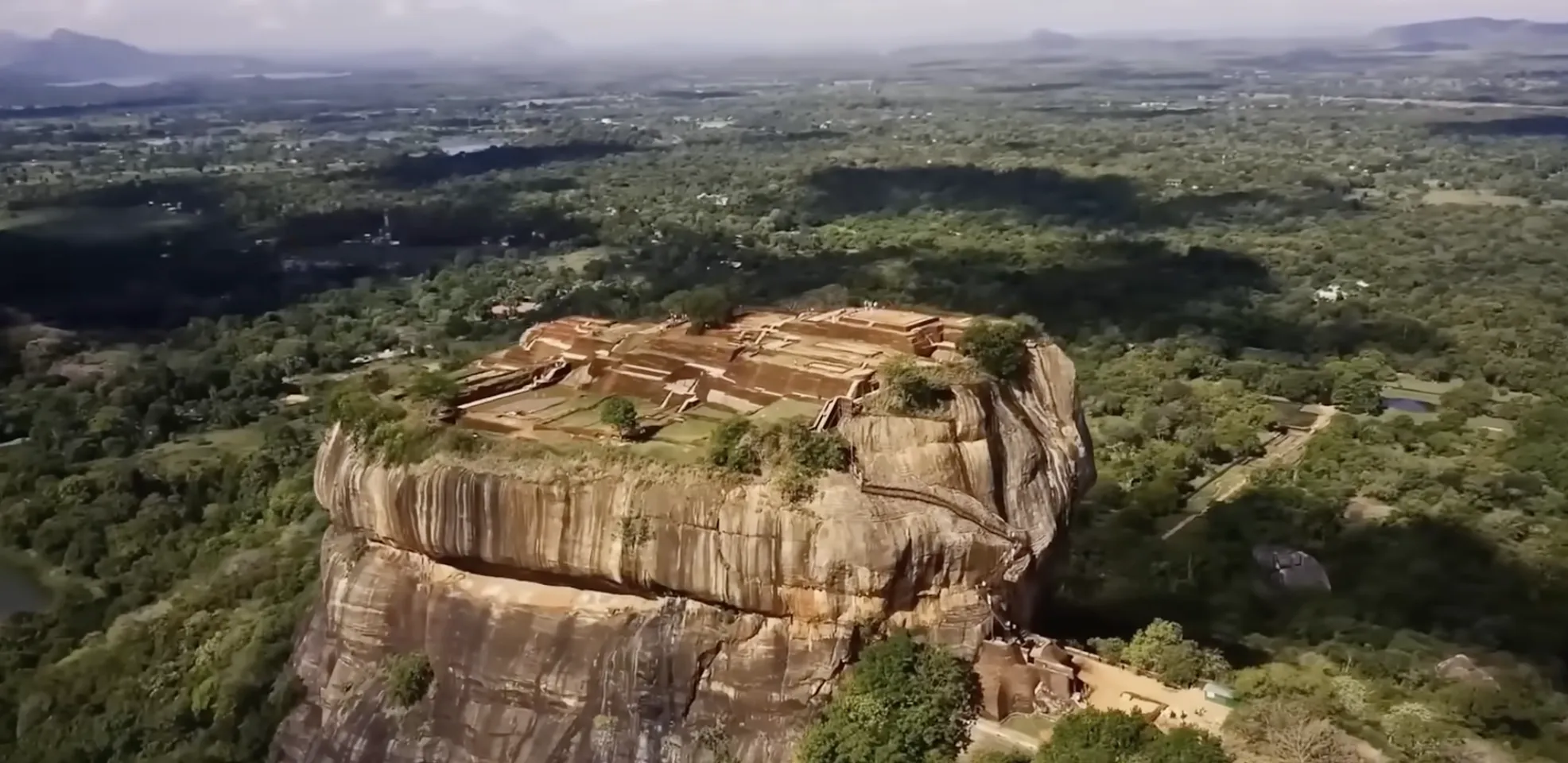
Content Disclaimer: This article contains speculative theories and hypotheses presented for entertainment and educational purposes. The content explores alternative interpretations of historical events and phenomena. Readers are encouraged to conduct independent research and form their own conclusions.
Major Jonathan Forbes stood in the dense jungles of Ceylon (modern Sri Lanka), staring up at something that made no sense. A 200-meter granite monolith rose before him, its summit flat as a table, crowned with the ruins of a massive complex.
But there were no stairs. No ramps. No visible way to reach the top.
When he asked the isolated Buddhist monks how the ancient builders reached the summit, their answer defied logic: "They flew."
Modern archaeology tells us Sigiriya was built by King Kashyapa between 477-495 CE-a paranoid ruler who murdered his father and brother, then fled to this rock fortress fearing assassination.
The timeline: 7 years to complete.
Let's examine what that means.
To build Sigiriya in 7 years requires 1,174 bricks transported daily to a 200-meter summit, thousands of tons of marble from quarries that don't exist in the region, 3,500 tons of granite removed to carve a single swimming pool, and zero visible construction infrastructure-no ramps, pulleys, or scaffolding remains.
Even with modern equipment, transporting materials to Sigiriya's summit takes 2 hours via metal staircases. Without stairs, the official timeline becomes physically impossible.
The summit is carved from Charnockite-a granite with a Mohs hardness of 7 (diamond is 10). The precision of the cuts and the smoothness of surfaces suggest advanced cutting tools beyond bronze or iron, chemical or vibrational softening of stone similar to findings in Peru and Egypt, and knowledge of material properties that modern science is only beginning to understand.
Underground irrigation channels still function 1,500 years later. Symmetrical garden layouts covering acres. Reservoir systems that store and distribute water year-round. Drainage networks that prevent flooding despite monsoon seasons.
The engineering sophistication rivals modern civil engineering projects.
The main structure aligns perfectly with equinox sunrises and sunsets, cardinal directions to sub-degree accuracy, and sacred geometry patterns found in Angkor Wat and Teotihuacan.
This wasn't a hasty fortress. This was a calculated cosmic structure built by minds that understood celestial mechanics.
Inside the 30-meter granite swimming pool, archaeologists found something disturbing: smooth, scooped depressions in solid granite.
These marks appear identical to the Granite Coffer in the Great Pyramid of Egypt, the Stone Blocks of Puma Punku in Bolivia, and the Megalithic Walls of Sacsayhuaman in Peru.
The pattern suggests a technology for stone softening-making rock pliable enough to scoop like ice cream, then allowing it to reharden.
No modern tool can replicate these marks. We don't have the technology.
The marble pathways and structures contain stone not found anywhere in Sri Lanka. Geologists have searched for the source quarry and found nothing.
Where did the marble come from? How was it transported through dense jungle to a vertical rock face with no roads?
The official answer: We don't know.
Scattered across Sigiriya's surface are deep, narrow holes drilled into solid granite. Some extend meters into the rock. The diameter remains consistent, which is impossible with primitive tools. The purpose remains unknown.
Near these holes are linear grooves and marks that some researchers suggest could be anchor points for levitation platforms-exactly as described in Vedic texts about Asura technology.
The Buddhist and Hindu communities that have guarded Sigiriya for centuries tell a different story.
Local tradition insists Sigiriya was built by Ravana, the legendary king of the Asuras, thousands of years before King Kashyapa was born.
According to these accounts, Ravana commanded Vimanas (flying vehicles), the Asuras possessed levitation technology, the fortress served as a gateway between dimensions, and the massive claw-like structures at the entrance represent reptilian guardians, not lions.
When Christianity and Islam spread to Sri Lanka, local traditions merged with Abrahamic narratives. Some believe Sigiriya is where Adam first landed after exile from Eden, that Adam's Peak 170 km away bears his footprint, and that the advanced technology was divine, not human.
This syncretism muddles the original story, but the core remains: Sigiriya predates recorded history.
Since 1982, Sigiriya has been a UNESCO World Heritage Site, attracting thousands of tourists annually. Yet UNESCO's own documentation struggles to explain how materials reached the summit, why no construction evidence remains, the source of advanced engineering knowledge, and the purpose of astronomical alignments.
The official narrative attributes everything to King Kashyapa's 22-year reign, with construction completed in 7 years.
But the physical evidence tells a different story-one of a civilization with capabilities we've lost or never possessed.
Mainstream archaeology refuses to address the contradictions. Where are the quarries for the marble? How were 3 million bricks transported without stairs? What created the scoop marks in granite? Why the astronomical precision for a paranoid king's hiding place? What is the purpose of the deep drill holes?
Instead, they recite the same narrative: A king built it in 7 years. Case closed.
Independent researchers attempting to study Sigiriya's anomalies face denied access to restricted areas, confiscation of samples for testing, dismissal by academic institutions, and ridicule in mainstream media.
The message is clear: Don't ask questions that challenge the official story.
Sigiriya contains evidence of pre-flood advanced civilization, lost technologies for matter manipulation, contact with non-human intelligences, and knowledge systems that threaten modern paradigms.
If Sigiriya wasn't built by a paranoid 5th-century king, then everything we think we know about ancient history crumbles.
And that's precisely why the truth must be suppressed.
No matter how hard they try to bury the truth, Sigiriya stands as testimony. 200 meters of impossibility. 3 million bricks with no stairs. Hydraulic engineering that works 1,500 years later. Stone manipulation beyond modern capability. Astronomical precision for cosmic alignment.
The fortress in the sky waits, challenging every visitor to ask the forbidden questions: Who really built this? And what else are they hiding?